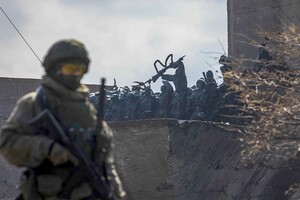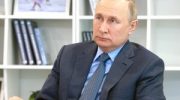The Ukrainian defense has proved that the old ideas about the balance of power on which Moscow relied no longer matter.

At the beginning of the Russian invasion of Ukraine Not only did Moscow believe that its offensive would succeed quickly. In February, even US officials warned that Kyiv could fall in a matter of days.
On the side of the Russian army were numbers, or rather one number – the rule of numerical ratio of forces 3 to 1, which the attacking side must follow to defeat the army in defense. This is one of the proportions popular in military strategy. It seemed that Russia had such an advantage, – writes the Wall Street Journal.
The war in Ukraine returned interest in the proportions of the balance of power. Among them are many other models that say how many troops are needed to defeat unprepared defense forces to suppress guerrilla resistance or counterattack on the flanks. These proportions have been studied by generations of tactics both in the United States and in the USSR, and now in Russia. They have become a convenient argument in favor of Ukraine's extreme vulnerability.
“I think most of those who think in such terms believe that a 3 to 1 advantage is needed to make a breakthrough. But it is clear that Russia has miscalculated, “said University of Chicago professor John Mirsheimer.
Read also: The war in Ukraine marked the beginning of the end of Putin – the leader of the ruling party of Germany
The Wall Street Journal provides examples of the balance of power in the case of different military operations. For example, to attack a prepared and fortified opponent requires a 3: 1 advantage. If the attack is unexpected for the defending side, then the ratio of forces should be at 2.5: 1. The counterattack on the flanks can be carried out with equal forces. And to keep the occupied territory, you need 20-25 soldiers per thousand population. Then the Wall Street Journal cites the balance of power between Russia and Ukraine before the war. For example, in terms of manpower, the Russian army had a 4.6: 1 advantage. The ratio of the number of tanks was 3.4: 1, and armored personnel carriers – 9.7: 1 in favor of Russia. The Russian side also had an advantage in the number of artillery at 2.7: 1.
Modern versions of the 3: 1 rule also apply to local combat sectors. The RAND Corp think tank has determined that a 1.5: 1 advantage in a broad theater of operations could allow the attacking side to reach a 3: 1 ratio in individual sectors. Prior to the February invasion, Russia drew 190,000 troops to the border while the Ukrainian army was scattered throughout the country. It seemed that the Russian army had a numerical advantage over the Armed Forces.
Stephen Biddle, a professor at Columbia University, concludes that Russia's failure underscores how much more complex modern wars are than similar proportional calculations. Biddle was a member of the analytical teams of Generals David Petraeus and Stanley McChrystal during the Iraq and Afghanistan wars.
“There is very little empirical evidence to support such calculations. This is not some scientific law. They correspond to intuitive understanding to some extent, but this is a lousy sociological theory, “he explained.
The proportions of the balance of power do not take into account Western intelligence and material support, the determination of the Armed Forces, do not take into account low Russian morale, major logistical problems of the Russian army or its gross tactical mistakes, says Biddle. He assures that the US Army uses more detailed analyzes in planning real combat operations. The proportions of the balance of power date back to the land wars in Europe in the 19th century. In his 1832 text on military strategy, Prussian General Karl von Clausewitz declared: “The defensive form of war is by nature always stronger than the offensive.” During the Franco-Prussian War of 1870, the Prussian army proved that the attacking side needed three times as much power to break through.
Read also: The war will not last for years, but for months – expert
The First World War, in which soldiers spent years in trenches because they could not break through the defensive lines, added extra weight to the very idea of proportions. Shortly after the end of the First World War, British Brigadier General James Edmonds also wrote about Rule 3: 1: to have a triple numerical advantage “. After the Second World War, the idea of the balance of power was actively used in the military doctrine of the USSR. The United States has used such calculations since 1955 to assess the potential results of military scenarios. Although there were skeptics. For example, U.S. Army General Omar Bradley criticized the proportional approach, saying it limited military tactics by reducing their calculations for the overall strategy to oversimplifications.
In the 1980s, balance of power assessments played a central role in the debate over whether the Warsaw Pact, led by the Soviet Union, which had a numerical advantage over NATO forces in Europe, could quickly win a war without nuclear weapons. On the one hand, Mirsheimer claimed that the forces of the “socialist camp” will find it difficult to achieve a 3: 1 advantage. So they will not be able to break up NATO quickly. He argues that both then and now, the proportional rule can only be applied to point battles aimed at breaking through.
Read also: The war in numbers: how big and small businesses have suffered
Other researchers, such as Joshua Epstein, have advanced dynamic mathematical models to estimate the balance of power. As a researcher at the Brookings Institution, he argued that the proportions were generally wrong. But before the consensus on these disputes arose, the Cold War was over. For the happy generation that was born after her, the great war in Europe seemed unthinkable. Epstein began to use his mathematical modeling to predict the spread of disease. He is now an epidemiologist at New York University. However, he still drew attention to the events in Ukraine.
“In this case, it is obvious that the balance of power, the numerical statistics of combat units can not predict what will actually happen on the battlefield,” he said./p> See special topic: Russian troops pull air defense systems on Snake Island The occupiers hope to gain control of the northwestern Black Sea. It is harder to help not those deported Ukrainians who want to leave Russia, but those who want to stay – a Russian human rights activist In economically disadvantaged regions, where mostly settle our people, able-bodied citizens, it will be very difficult for them to find work, and for the elderly – to provide social protection. The occupiers fired on a border settlement in the Chernihiv region 8 explosions were recorded on the outskirts of Bleshnia. The Interior Ministry has explained why Russia will try to prolong the war until the end of the year Blackmail remains one of the Kremlin's main diplomatic tools. Russia has already exhausted the reserves of combat-ready battalion-tactical groups – GUR of the Ministry of Defense However, Russia still has enough reserves to send to Ukraine.




